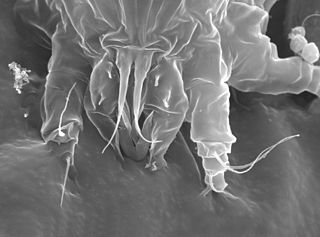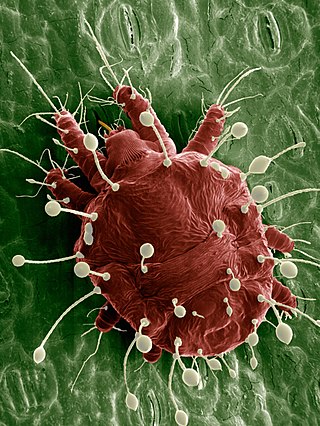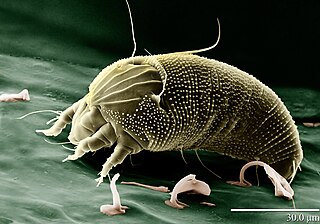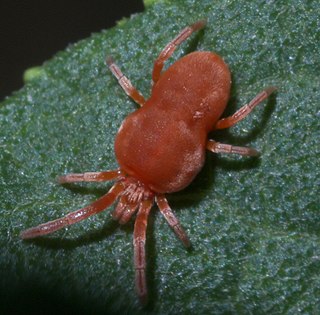Related Research Articles

Mites are small arachnids. Mites span two large orders of arachnids, the Acariformes and the Parasitiformes, which were historically grouped together in the subclass Acari. However, most recent genetic analyses do not recover the two as each other's closest relative within Arachnida, rendering the group non-monophyletic. Most mites are tiny, less than 1 mm (0.04 in) in length, and have a simple, unsegmented body plan. The small size of most species makes them easily overlooked; some species live in water, many live in soil as decomposers, others live on plants, sometimes creating galls, while others again are predators or parasites. This last type includes the commercially destructive Varroa parasite of honey bees, as well as scabies mites of humans. Most species are harmless to humans, but a few are associated with allergies or may transmit diseases.

Eriophyoidea are a superfamily of herbivorous mites. All post-embryonic instars lack the third and fourth pairs of legs, and the respiratory system is also absent.

Raoiella indica, commonly known as the red palm mite, is a species of mite belonging to the family Tenuipalpidae. A pest of several species of palm in the Middle East and South East Asia, it is now becoming established throughout the Caribbean. The invasion of this species is the biggest mite explosion ever observed in the Americas.

Floracarus perrepae is a species of herbivorous mite belonging to the family Eriophyidae. It is native to Australia (Queensland), China and New Caledonia. As it is known to attack and eat the invasive fern species Lygodium microphyllum, it is being considered for use as a biological pest control agent in Florida.

Aceria anthocoptes, also known as the russet mite, rust mite, thistle mite or the Canada thistle mite, is a species of mite that belongs to the family Eriophyidae. It was first described by Alfred Nalepa in 1892.

Brevipalpus phoenicis, also known as the false spider mite, red and black flat mite, and in Australia as the passionvine mite, is a species of mite in the family Tenuipalpidae. This species occurs globally, and is a serious pest to such crops as citrus, tea, papaya, guava and coffee, and can heavily damage numerous other crops. They are unique in having haploid females, a condition caused by a bacterium that change haploid males into females.
Charletonia cuglierensis is a species of mite belonging to the family Erythraeidae, so named after its type locality. C. cuglierensis belongs to the group of species which possess two setae between coxae II and III. It differs from its cogenerate species by length measurements. It was first found in Sardinia, 6 kilometres (3.7 mi) south of Cuglieri.
Leptus pozzoicus is a species of mite. It is named after Porto Pozzo, near Santa Teresa Gallura, the place where the species was first collected. L. pozzoicus belongs to the group of species with two palpgenualae, and that have over four setae between coxalae II and III. It differs from its cogenerate species by various length measurements.
Charletonia austisensis is a species of mite belonging to the family Erythraeidae. C. austisensis belongs to the species group with two setae between coxae II and III. It differs from its cogenerate species by various length measurements. The species was first found in Austis, Sardinia, after which it is named.
Abrolophus mirabelae is a species of mite belonging to the family Erythraeidae. It belongs to the group of species that have comb-like setae.
Erythraeus berninensis is a species of mite belonging to the family Erythraeidae. It belongs to the group of species that has a basifemoral, setal formula 3-3-3.
Allothrombium polikarpi is a species of mite belonging to the family Trombidiidae, first described from Greece.
Podothrombium manolatesicus is a species of mite belonging to the Trombidiidae family, first derived from Greece.
Erythraeus (Zaracarus) passidonicus is a species of mite belonging to the family Erythraeidae, first described from Greece.
Erythraeus kastaniensis is a species of mite belonging to the family Erythraeidae, first described from Greece.
Charletonia samosensis is a species of mite belonging to the family Erythraeidae, first described from Greece.
Charletonia kalithensis is a species of mites belonging to the family Erythraeidae, first described from Greece.

Allothrombium is a genus of mites belonging to the family Trombidiidae.
Charletonia is a genus of mites belonging to the family Erythraeidae.
References
- ↑ Haitlinger, R. Y. S. Z. A. R. D. "New records of mites (Acari: Prostigmata: Erythraeidae, Trombidiidae, Eutrombidiidae) from France, Liechtenstein and Switzerland, with descriptions of three new species." Systematic and Applied Acarology 12.1 (2007): 55.